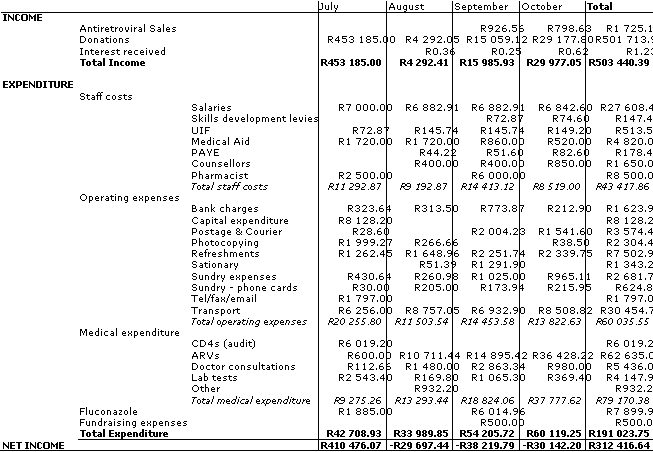| The TAC Treatment Project |
|
| You can save a life! > Reports > January 2004 > Finances | ||||||||||
FinancesFundraisingMost of the Treatment Projects funding has come in the form of large donations by individuals and institutions (including the largest, $150 000 from the Amandla AIDS fund of Articsts for a New South Africa). In the short term we will continue to raise funds in this way in order to build a secure base of funds. However, in the medium to long term the fundraising strategy will focus on convincing ordinary South Africans to make regular (monthly) contributions by debit order or otherwise. A number of facilities have already been put in place for this purpose: debit order facility, a credit card terminal, internet credit card donation facility and tax-deductible donations in the US, UK and Germany via partners there). Also, pamphlets with pledge forms (among other things allowing debit orders) were produced. So far about 3000 pamphlets have been distributed and several thousand rands are donated every month by debit order. Varying amounts are also deposited directly or by credit card every month. In partnership with the Charisites Aid Foundations give as you earn programme, payroll-based contributions are also now possible. Contributions made by employees of non-profit organisations are matched by CAF. While some progress has been made, it is clear that a coherent fundraising strategy must be developed and implemented. The board will be asked to endorse an interim fundraising committee that has been established to lead this process. Current financial position
Expenditure report: July October 2003The TAC Treatments non-medical expenditure is currently much higher than might be anticipated. As explained earlier in this report, development of infrastructure, selection and preparation of patients is costing large amounts of money. As treatment is scaled up, economies of scale should improve. On the next page follows a detailed breakdown of expenditure during the first six months of the project (May to October 2003). Please bear in mind that some expenses already incurred (e.g. many CD4 counts) have not yet been paid and others (e.g. ARV orders) include stock not yet utilised. Also note the following: · Current ratio of operating expenditure to medical expenditure is 1:1.32. This needs to be no more than 1:2. This reflects, however, startup costs and disproportionate spending on the selection process. · Current breakdown of costs does not allow us to determine which operating expenses refer to the wellness programme/selection process and which to treatment support. This will be corrected before the annual financial statements are produced. · The ANSA and some other donations are not yet reflected in these statements. Consolidated income and expenditure by month
Fundraising prospects for 2004In addition to the grant of US$150 000 from the Amandla AIDS fund, a further $150 000 was pledged as matched funding (i.e. to be disbursed if matched by other North American donors). It is expected that this will be achieved.
It is anticipated that this amount, plus regular monthly contributions will add at least another R1 million to the TAC TPs coffers. Applications will be made to the Global Fund for AIDS, TB and Malaria, as well as the World Banks dedicated HIV/ADIS treatment fund. It is hoped that up to R10 million will be raised in this way, enabling up to 1 000 patients to receive antiretroviral therapy (at current drug prices, which may come down significantly) and a wellness programme for 5 000 TAC members to be established. |
| < | TOP |
